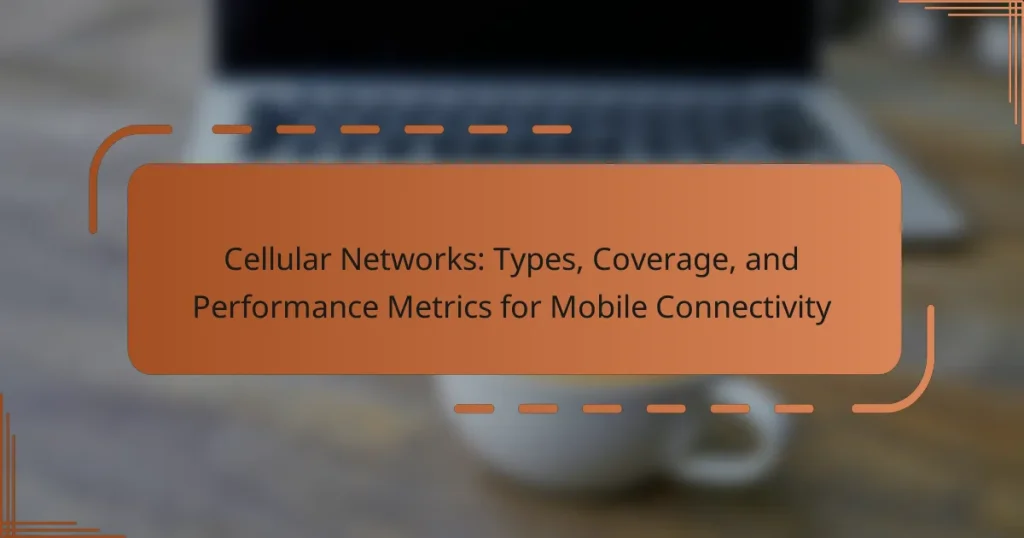Cellular networks are communication systems that utilize radio waves to connect mobile devices to a central network through a series of cells, each served by a base station. This article explores the various types of cellular networks, including their coverage areas and performance metrics, which are vital for mobile connectivity. Key topics include the evolution of cellular technology from 1G to 5G, the role of frequency bands in supporting multiple users, and the importance of mobility in maintaining connectivity. The discussion will provide insights into how these networks facilitate voice calls, text messaging, and data transmission, underscoring their significance in modern communication and internet access.

What are Cellular Networks?
Cellular networks are communication systems that use radio waves to connect mobile devices to a central network. They consist of multiple cells, each served by a base station. These base stations facilitate wireless communication within their coverage area. Cellular networks enable voice calls, text messaging, and data transmission. They operate on various frequency bands, allowing multiple users to connect simultaneously. The technology has evolved from 1G to 5G, enhancing speed and capacity. Cellular networks support mobility, allowing users to move while maintaining connectivity. They are essential for modern mobile communication and internet access.
How do Cellular Networks function?
Cellular networks function by using a system of interconnected base stations to provide wireless communication. Each base station covers a specific area called a cell. Mobile devices connect to the nearest base station, enabling voice and data transmission. The network employs frequency reuse to maximize capacity. Signals are transmitted through radio waves between the device and the base station. The base station connects to a central network that routes calls and data. This architecture allows for efficient resource allocation and handovers when devices move between cells. Cellular technology has evolved from 1G to 5G, enhancing speed and connectivity.
What components are essential in a Cellular Network?
Essential components of a cellular network include base stations, mobile devices, and core network elements. Base stations, also known as cell sites, facilitate communication between mobile devices and the network. They transmit and receive radio signals to establish connections. Mobile devices, such as smartphones, connect to these base stations to access network services. Core network elements manage data routing and ensure connectivity across the network. These elements include routers, switches, and servers. Together, these components enable efficient communication and data transfer within a cellular network.
How do these components interact to provide connectivity?
Cellular network components interact through a structured hierarchy to provide connectivity. Base stations, also known as cell towers, transmit and receive signals from mobile devices. These signals are then processed by the mobile switching center (MSC), which manages call routing and handovers. The MSC connects to the core network, which includes databases for user information and service management.
Radio frequency (RF) spectrum facilitates communication between the base stations and devices. This spectrum is divided into channels, allowing multiple connections simultaneously. Network protocols ensure that data packets are transmitted accurately and efficiently.
The interaction of these components enables seamless communication, allowing users to make calls, send messages, and access the internet. For instance, when a user initiates a call, the device sends a signal to the nearest base station. The base station communicates this to the MSC, which establishes a connection to the recipient’s device.
This systematic interaction ensures reliable connectivity across various geographical areas and user demands.
What are the main Types of Cellular Networks?
The main types of cellular networks are 2G, 3G, 4G, and 5G. Each generation represents a significant advancement in mobile technology.
2G networks introduced digital voice services and basic data transmission. They enabled SMS and MMS functionalities.
3G networks enhanced data speeds and introduced mobile internet access. They supported video calling and mobile broadband services.
4G networks further improved data speeds and reduced latency. They enabled high-definition video streaming and online gaming.
5G networks offer ultra-fast speeds, low latency, and support for a massive number of connected devices. They enable advanced applications like IoT and augmented reality.
These advancements illustrate the evolution of cellular technology, enhancing connectivity and user experience.
What distinguishes 2G, 3G, 4G, and 5G networks?
2G, 3G, 4G, and 5G networks are distinguished by their generation and technological advancements. 2G introduced digital voice services and basic data transmission, supporting speeds up to 64 Kbps. 3G networks enhanced data capabilities, enabling mobile internet access with speeds ranging from 200 Kbps to several Mbps. 4G networks further improved speed and reliability, offering download speeds exceeding 100 Mbps and supporting high-definition streaming. 5G networks represent the latest advancement, providing ultra-fast speeds up to 10 Gbps, low latency, and support for a massive number of connected devices. Each generation builds upon the previous one, incorporating new technologies and standards to enhance mobile connectivity.
How do different types of networks impact mobile connectivity?
Different types of networks significantly impact mobile connectivity by influencing speed, reliability, and coverage. Cellular networks, including 4G and 5G, offer varying data transfer rates. For instance, 5G networks can provide speeds up to 10 Gbps, whereas 4G networks typically reach up to 1 Gbps.
Network architecture also plays a role. Dense urban areas benefit from small cell networks, enhancing capacity and reducing latency. In contrast, rural areas may rely on larger cell towers, which can limit speed and reliability.
Additionally, the technology used in the network affects connectivity. LTE Advanced enhances 4G networks, improving performance in congested areas. Overall, the type of network determines the user experience in terms of data speed and connection stability.
What Coverage options are available in Cellular Networks?
Cellular networks offer several coverage options, including urban, suburban, and rural coverage. Urban coverage provides high-density service with extensive infrastructure. Suburban coverage typically extends service to less populated areas with moderate infrastructure. Rural coverage aims to connect remote areas with limited infrastructure. Each type of coverage is designed to meet the specific needs of different population densities. The effectiveness of these coverage options can vary based on factors like terrain, network technology, and frequency bands used. For instance, higher frequency bands may provide better urban coverage but have limited range in rural areas.
How is coverage area determined in Cellular Networks?
Coverage area in cellular networks is determined by several factors, including the frequency of the signal, the power of the transmitter, and the geographical terrain. Higher frequency signals have shorter wavelengths and are more affected by obstacles, resulting in smaller coverage areas. Conversely, lower frequency signals can travel longer distances and penetrate obstacles better, leading to larger coverage areas. The power of the transmitter also plays a critical role; higher power increases the coverage radius. Additionally, geographical features such as mountains, buildings, and trees can obstruct signals, reducing coverage. Network design, including the placement and density of cell towers, further influences coverage area. For instance, urban areas may require more towers to ensure adequate coverage due to higher obstructions.
What factors influence the coverage quality?
Coverage quality in cellular networks is influenced by several key factors. These factors include signal strength, interference levels, and environmental conditions. Signal strength is critical; higher signal strength typically leads to better coverage quality. Interference from other electronic devices can degrade signal quality. Environmental conditions such as buildings, terrain, and weather also impact coverage. For instance, urban areas with tall buildings can obstruct signals, reducing coverage quality. Additionally, the frequency band used affects coverage; lower frequencies generally penetrate obstacles better than higher frequencies. Network density, or the number of base stations in a given area, also plays a significant role. More base stations usually enhance coverage quality by reducing the distance between the user and the network.
What Performance Metrics are used to evaluate Cellular Networks?
Cellular networks are evaluated using several performance metrics. Key metrics include signal strength, which measures the power level received by the device. Another important metric is data throughput, indicating the amount of data transmitted over a network in a given time. Latency is also crucial; it assesses the time taken for data to travel from source to destination.
Call drop rate measures the frequency of dropped calls during a conversation. Packet loss indicates the percentage of data packets lost during transmission. Network availability reflects the percentage of time the network is operational. Finally, user experience metrics gauge overall satisfaction with network performance. These metrics are essential for assessing the effectiveness and reliability of cellular networks.
How is network speed measured in Cellular Networks?
Network speed in cellular networks is measured using metrics such as data rate, latency, and throughput. Data rate refers to the amount of data transmitted over a network in a given time, typically measured in megabits per second (Mbps). Latency indicates the time it takes for data to travel from the source to the destination, measured in milliseconds (ms). Throughput represents the actual data transfer rate experienced by users, which can be affected by various factors, including network congestion and signal strength. These measurements help assess the performance and efficiency of cellular networks. For example, 4G networks typically offer speeds ranging from 5 to 100 Mbps, while 5G networks can reach speeds exceeding 1 Gbps under optimal conditions.
What role does latency play in network performance?
Latency is the time it takes for data to travel from the source to the destination in a network. It significantly impacts network performance, affecting user experience and application responsiveness. High latency can lead to delays in data transmission, causing slow loading times for websites and applications. In cellular networks, latency is influenced by factors such as distance to the cell tower and network congestion. For instance, 4G networks typically have a latency of 30-50 milliseconds, while 5G networks aim for as low as 1 millisecond. Lower latency improves real-time applications like gaming and video conferencing, enhancing overall performance.
How do Cellular Networks adapt to user demands?
Cellular networks adapt to user demands through dynamic resource allocation and network optimization techniques. They utilize algorithms to manage bandwidth and prioritize traffic based on current usage patterns. For instance, during peak hours, networks may allocate more resources to high-demand applications like video streaming. Technologies such as beamforming and MIMO enhance signal quality and capacity, improving user experience. Additionally, network operators employ data analytics to predict usage trends and adjust infrastructure accordingly. This adaptability is crucial for maintaining service quality and meeting user expectations in real-time.
What technologies enhance the adaptability of Cellular Networks?
Technologies that enhance the adaptability of cellular networks include Software-Defined Networking (SDN), Network Functions Virtualization (NFV), and 5G technology. SDN allows for dynamic network management and reconfiguration. NFV enables the virtualization of network services, improving flexibility. 5G technology introduces advanced features like network slicing and ultra-reliable low-latency communication. These technologies collectively support efficient resource allocation and rapid response to changing network demands. For instance, 5G can handle diverse applications simultaneously, optimizing performance across various use cases. The integration of these technologies is pivotal for modern cellular networks to adapt to user needs and traffic patterns effectively.
How do network upgrades affect performance and coverage?
Network upgrades enhance performance and coverage by improving data speeds and expanding service areas. Upgrades often involve the installation of advanced technology, such as 5G infrastructure. This technology enables higher frequency bands, which can carry more data simultaneously. Consequently, users experience reduced latency and faster download speeds.
Additionally, network upgrades can incorporate more base stations, which increases coverage in previously underserved areas. A study by the Federal Communications Commission (FCC) found that 5G upgrades can increase network capacity by up to 100 times compared to 4G.
These improvements lead to better overall user experiences and support for more devices. Enhanced performance and coverage are critical for supporting emerging technologies like IoT and smart cities.
What are the common challenges faced by Cellular Networks?
Cellular networks face several common challenges. One major challenge is network congestion. This occurs when too many users attempt to access the network simultaneously. It results in slower data speeds and dropped calls. Another challenge is interference. Interference can come from physical obstacles or other electronic devices. This can degrade signal quality and affect communication. Coverage gaps are also a significant issue. These gaps occur in rural or densely populated areas. They lead to inconsistent service and limited accessibility. Additionally, security vulnerabilities exist within cellular networks. These vulnerabilities can expose user data to unauthorized access. Finally, the rapid pace of technological change presents a challenge. Network operators must continuously upgrade infrastructure to keep up with advancements.
How do interference and congestion impact network performance?
Interference and congestion negatively impact network performance. Interference occurs when unwanted signals disrupt communication. This can lead to reduced signal quality and increased error rates. Congestion happens when too many users access the network simultaneously. This results in slower data rates and longer response times. Studies show that high interference can decrease throughput by up to 50%. Additionally, congestion can cause dropped calls and delayed connections. These factors significantly degrade user experience in cellular networks.
What strategies are employed to mitigate these challenges?
Strategies employed to mitigate challenges in cellular networks include enhancing infrastructure, optimizing spectrum usage, and deploying advanced technologies. Infrastructure enhancement involves building more cell towers to improve coverage and reduce dead zones. Optimizing spectrum usage allows for better allocation of frequencies, minimizing interference and maximizing capacity. Advanced technologies such as MIMO (Multiple Input Multiple Output) and beamforming improve signal quality and network efficiency. Implementing small cells in urban areas helps manage high traffic loads effectively. Regular network monitoring and maintenance ensure optimal performance and quick resolution of issues. These strategies collectively enhance user experience and network reliability.
What best practices can enhance Cellular Network performance?
Implementing best practices can significantly enhance cellular network performance. Regularly optimizing network configuration improves signal strength and quality. Upgrading to advanced technologies like 4G and 5G increases data speeds and capacity. Conducting routine maintenance prevents outages and ensures reliability. Monitoring network traffic helps identify congestion and allows for load balancing. Utilizing small cells enhances coverage in high-density areas. Implementing Quality of Service (QoS) policies prioritizes critical applications and improves user experience. These practices are supported by research indicating that optimized networks can achieve up to 50% better performance metrics.
How can users optimize their devices for better connectivity?
Users can optimize their devices for better connectivity by adjusting settings and managing their environment. First, ensure that the device’s software is up to date. Regular updates can improve performance and security. Next, users should check their network settings. Switching between 4G and 5G can enhance speed and reliability.
Additionally, users should turn off unused applications that consume bandwidth. Background apps often reduce overall connectivity quality. Users can also improve signal strength by avoiding physical obstructions. Thick walls and electronic devices can interfere with signals.
Positioning the device near a window can enhance reception. Using Wi-Fi calling when cellular signals are weak can also improve connectivity. Lastly, users should consider a signal booster if they frequently experience weak signals. These steps collectively enhance device connectivity in cellular networks.
What steps can network providers take to improve service quality?
Network providers can improve service quality by upgrading infrastructure and expanding coverage. Investing in modern technology, such as 5G, enhances speed and reliability. Regular maintenance of existing equipment ensures optimal performance. Providers should conduct network assessments to identify weak areas. Implementing Quality of Service (QoS) protocols prioritizes critical traffic. Offering customer support and feedback channels helps address issues promptly. Monitoring network performance metrics allows for data-driven improvements. These steps lead to higher customer satisfaction and retention.
Cellular networks are communication systems that connect mobile devices to a central network using radio waves and base stations. This article provides a comprehensive overview of cellular networks, covering their types, including 2G, 3G, 4G, and 5G, and how each generation has evolved to enhance mobile connectivity. It also details the essential components that facilitate network function, the factors influencing coverage and performance metrics, and the challenges faced by these networks. Additionally, best practices and strategies for optimizing both user devices and network performance are discussed, providing insights into improving mobile connectivity.


